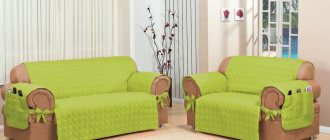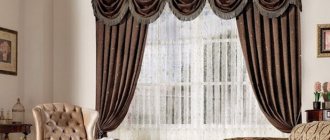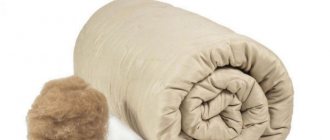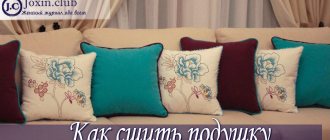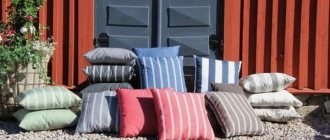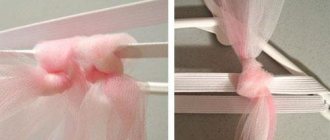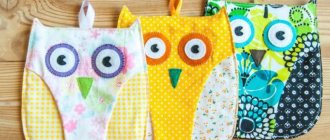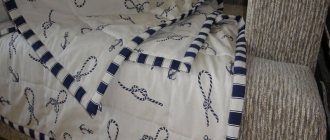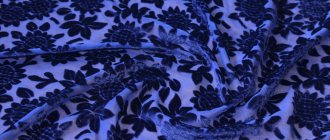Sewing a bedspread with your own hands is not only a way to save on a factory product, but also an opportunity to bring a piece of your soul into the interior. A bedroom is a place where a person spends a significant part of his life, so it is important to make this space as comfortable as possible for relaxation.
Any textile products create an extraordinary atmosphere of comfort in the room; making them yourself using detailed instructions is very simple. Today we will talk about how to create a bedspread.
DIY bedspread
How to choose fabric for a bedspread?
Of course, for most people, the main criterion for choosing a particular fabric is its combination with other interior items. At the same time, it is worth paying attention to the texture of the material and its quality. We will look at the most popular types of textiles used to create blankets.
Table No. 1. Fabrics for bedspreads
| View, illustration | Description |
| Fur | There are both artificial and natural fur fabrics - in both cases, such a product will be very warm. However, these types of bedspreads are not suitable for everyone. After all, they are quite difficult to wash, and sometimes you even have to use dry cleaning services. |
| Wool | As in the previous case, woolen products will be very warm. In addition, they have good wear resistance and better absorb excess moisture. It is worth noting that such material has a different texture, it can be a little thicker or thinner, and the final appearance of the product depends on this. The finer the wool, the lighter and airier the blanket will be. |
| Silk | This is also a fairly popular material, which is used in the manufacture of various bedding. This blanket will be comfortable to cover yourself with, silk is very pleasant to the skin. The main disadvantage is that silk will require special care - extremely delicate washing. |
| Fleece | A very soft material that can be used to make baby blankets. Fleece will not leave irritation on delicate skin, moderately warms, is durable and has an aesthetic appearance. |
| Cotton | Natural fabric, which is also often used to create children's products. Compared to the previous option, cotton fabric may seem less comfortable for the baby, since natural cotton is not soft enough and does not warm well. |
| Jacquard | This is a material that has an unusual decorative appearance. Thanks to its unique texture and patterns, it looks expensive, and such a bedspread can become an unusual accent in any interior. |
| Bamboo | This material is made by weaving bamboo fibers. It is environmentally safe. At the same time, bamboo products do not require special care; they are quite resistant to wear. |
| Velvet | This is a dense, noble material, on the surface of which there are sometimes ornaments. It is often used to create various decorative bedspreads for bedrooms furnished in a classic style. |
| Linen | This is a durable material that is also suitable for creating a bedspread. The only downside is that it is difficult to smooth out without using a steamer. But for some interiors this is even a plus, since an unironed linen bedspread gives a special charm and a certain carelessness. |
| Satin | This material is best suited for making a lightweight bedspread. Any images on its surface do not fade for a long time, just as the plain fabric itself does not lose color even with numerous washes. |
| Velours | This fabric can be classified as velvet analogues. At the same time, velor is less demanding in care, it is easy to wash and then dry. |
What should a baby blanket be like?
Before choosing materials and sewing, let's figure out what a baby blanket should be like.
Necessary requirements:
- compliance of the product with the season and temperature in the room where the child sleeps: if you choose the wrong blanket, the child may overheat, which can lead to heat rash and poor health, or freeze,
- a suitable size for the child: a product that is too small will not be able to warm the child, it will be uncomfortable for him, since with almost any movement the blanket will slide off, and too large will interfere with the baby’s free movements,
- light weight: a product that is too heavy can make it difficult for the child to breathe and disturb his sleep,
- lack of decorative elements: the child may get entangled in them or damage the skin.
Based on the standard ratio of height and weight of children from birth to 17 years old, you can determine whether increases or decreases are needed when sewing.
I bought my son a couple of blankets measuring 80x80 centimeters for his birth, he slept under them until he was almost two years old, despite the fact that he is very tall for children of his age. Later we bought a blanket 110x150, I think it will last him until he is about four years old. Therefore, in my opinion, all these standard sizes are quite subjective.
Before using the blanket, make sure that there are no threads sticking out anywhere! The baby may cut himself on them.
If the blanket meets all the listed requirements, you can rest assured that your baby will be safe and sleep well.
Table: standard sizes of children's blankets
| Infants (0–1 year) | 80x80 100x135 150x110 |
| Children from 1 year to 12 years | 100x140 120x150 |
| Teenagers 13–17 years old (one and a half years old) | 145x210 160x220 |
Optimal bedspread size
In order to understand what size bedspread we need, we need to take measurements from the bed itself (length, width). It is worth noting that the product that hangs down from the mattress looks best, so you should add about 60 centimeters to the width of the bed, and 30 centimeters to the length.
An example of a voluminous satin bedspread
Preparing for sewing
Sewing a bedspread is not the most difficult task if you take your time and proceed consistently. First, you should make a pattern on a reduced scale. This step will allow you to determine how much fabric you will need to purchase and will allow you to better understand the entire process.
Step-by-step instructions for making the simplest bedspread are quite simple:
- Measure the bed in length and width. If necessary, measure the height to the floor (if you plan to make a flowing bedspread).
- Add a few centimeters on each side to the hem.
- If frills are planned, then the total length of the sides of the bed with frills is multiplied by 1.5. This will help make beautiful folds. The height of the frill will correspond to the height to the floor.
- Buy fabric.
- If necessary (large bed size), sew two fabrics.
- Finish the edges.
- Gather and sew on the frill.
If a frill is not provided, then the edges are simply folded and processed.
How to choose a color?
The choice of a particular color of the bedspread is influenced by the following nuances:
- If we are talking about a classic interior, then you need to choose a bedspread that matches the color of the curtains or wallpaper. For less austere interiors, you should choose colors that are basically present in the room - the bedspread can be in harmony with the color of the lampshade, flower pots, and carpet.
- The design in which the bedspread is combined with the walls looks quite interesting. So, if the walls have light green wallpaper, then you can choose fabric in the trendy mint color.
- You are allowed to choose a blanket to match the color of the furniture set. This is especially suitable in cases where the bed has a voluminous decorative headboard.
- To decorate a room, you can choose shades from one palette. So, if the curtains, wallpaper and other elements in the room are light pink, then you can choose bright crimson fabric for the blanket.
- If the room is decorated in pastel colors, then the blanket can be made in any bright color. It will serve as an unusual color accent.
It is advisable to choose a bedspread that matches the tone of the walls
Bright patterns
A hippie-style blanket will appeal to cheerful, extraordinary individuals. This option will add variety to any interior. If the blanket is not stored in plain sight, then the thing will become an excellent “breath of air” in a boring minimalist or classic interior.
Knitting the product is simple: just take skeins of thread of different colors. You can use any riot of colors. It is permissible to knit according to a simple pattern, for example, using a granny square. During the work process, threads of different colors are alternated. The sequence and combinations are selected individually.
We sew a bedspread with our own hands
There are a wide variety of techniques for making a bedspread with your own hands. The most popular ones should be highlighted:
- patchwork;
- counterpane;
- with frill;
- made of pompoms (suitable for a crib).
Patchwork blanket
Patchwork style bedspread: step by step instructions
To make such a product we will need the following:
- sewing machine;
- threads, needles;
- fabric - patchwork involves the use of fragments of material, so even old jeans and sweaters are suitable for such purposes;
You can read about how to sew a blanket from old jeans with your own hands in our article.
- lining fabric (since this is a bedspread, you don’t need to use a thick padding polyester lining);
- cardboard - it will be easier to display the pattern of the future drawing on it;
- scissors, chalk;
- iron;
- tape measure.
The following tools and materials will be useful during the work process:
Step 1. First, you need to prepare templates from cardboard. For the bedspread itself, you can use pieces of fabric of any shape, including squares, rectangles, and triangles. However, the simplest shape is a square. This type of blanket is most suitable for beginners.
This is what the square template diagram looks like. It can be displayed on cardboard in any size. Just keep in mind that 1 centimeter is always left as an allowance
Regardless of the choice of one shape or another, it is necessary to leave a few millimeters of allowance
Step 2. Next, you will need to take fabrics of various colors and cut out parts from them exactly according to the chosen template. At the same stage, you have to think about the appearance of the finished product. You can transfer the color scheme to your notebook so as not to get confused.
The pieces should be placed in the order in which they are planned to be sewn together.
Step 3. The next step is to prepare the parts that will be easy to connect together. To do this, it is better to wash all the pieces of the future bedspread with powder and conditioner, then iron them thoroughly. The simplest version of patchwork is considered to be the production of strips that will be easy to connect with each other. This process will only take a few hours, but as a result we will get a single color canvas.
It is necessary to sew the strips exactly according to the width of the finished blanket
Step 4. Now we need to carefully iron the seams on the wrong side of our workpiece. This should be done carefully so as not to wrinkle the bedspread.
Ironing the back side of the bedspread
Step 5. Next, according to the size of the resulting patchwork fabric, you need to cut out the reverse side for our bedspread. For this purpose, it is best to use cotton fabric.
We cut out another part of the bedspread, spreading the fabric on a flat surface
Step 6. Now you should lay the lining fabric on the floor, right side down. Then another piece of fabric (insulation) is placed on it. To keep it on the surface, you can fix it with tape. It is important that the insulation is 5 centimeters less at the edges than other parts.
You will need to put a patchwork fabric on top of this material, after which you should connect all these parts with pins
Step 7. Now you need to sew all these parts together.
A special embroidery foot is used during the work process.
If desired, you can make a decorative edging of the finished blanket using braid, ribbon and other details. Some craftswomen prefer to make a frill from the same material.
Quilted bedspread: step-by-step instructions
This technique allows you to get a product no less beautiful than in the patchwork style. The difference is that solid pieces of fabric are used here, rather than scraps.
During the work we will need the following:
- sewing machines;
- cotton (or any other fabric of your choice) for lining;
- thin insulation;
- edging fabric;
- threads, needles;
- tape measure;
- ruler;
- chalk;
- sample.
Step 1. To begin with, it is recommended to wash all fabric elements (except for insulation). If this is not possible, then you should at least treat the fabric with hot steam from an iron. This must be done so that the blanket does not “shrink” as a result of subsequent washing.
We wash all fabric cuts
Step 2. Now the fabric should be placed on a flat surface. If it is a floor, then it is recommended to wash it first. For the front part of the bedspread, double-sided cotton fabric with a pattern is usually used. It should be of optimal width to eliminate unnecessary seams. From this material you need to cut a square measuring 230x230 centimeters (the dimensions may be different, at your own discretion). Its edges should be finished with an overlocker.
How to choose the right overlocker
Fabric preparation
Step 3. You will also need to cut a square from the lining fabric. Its dimensions will be slightly larger - 240x240 centimeters. The edges are also processed with an overlocker, and the allowances should be smoothed with an iron.
Square of lining fabric
Step 4. Since the stitches will be square, we will need a square template. The size of the square will be 23x23 centimeters. Now we need to use a textile marker and a long ruler to draw out the facing material from the reverse side into squares. You should start from the edge, moving towards the central part. At this stage, you will need to perform all actions with the utmost care. After all the lines have been drawn, you can put this template aside.
Using a square template
Important point! To ensure that the fabric lies flat on the floor, it is recommended to secure it with adhesive tape.
Step 5. Now you need to lay out the lining fabric on the floor and place a thin padding polyester on top of it. These parts must be secured together with large stitches. Now the facing fabric is laid on this blank, lines up. At this stage, you need to make sure that all parts of the fabric are positioned evenly without distortion.
Lay out all the layers of fabric one by one
Step 6. Now you can connect all parts of the future bedspread with light threads and a needle. You should sew from the middle, first in one direction and then in the other.
Sew the parts together
Important point! When you baste, try to avoid knots so that the threads can be easily removed.
Step 7. Now we need to quilt the blanket using a sewing machine. You should also stitch from the middle to the edges. First you will need to make all the transverse stitches, and only then the longitudinal ones. In this way, you should quilt all the free areas of the bedspread.
Sewing the quilt pieces using a sewing machine
For greater convenience, you need to fold the edges of the bedspread towards the middle
In addition, you should place a chair next to the sewing machine to fold the finished product. The sides of the blanket should be trimmed using the same long ruler. Excess material can be cut off with scissors.
Important point! The product must be stitched exactly according to the markings. In this case, it is better to slightly tighten the fabric.
Step 8. Now all that remains is to attach the fabric edging to the bedspread and carefully smooth it with an iron.
Sew the edging to the product
How to make a frill for a bedspread?
Quite often, this type of blanket decoration is used if the product has uneven corners. To get started we will need:
- choose a plain material that will match the overall design of the blanket;
- In order to buy the optimal amount of fabric, everything should be taken into account, including the features of the corners and the width of the gather.
Important point! To create a frill pattern, you do not need to use only a whole piece of fabric. You can even use small pieces of fabric that will have to be sewn together (you will have to think about how to hide such seams).
Step-by-step instruction
Step 1. First of all, we need to take a ready-made quilted bedspread and make a pattern according to its dimensions.
Take the finished bedspread
Step 2. The next step is to make a edging pattern. To do this, you need to pin the material for the frill around the 100 centimeter perimeter. Now this fabric needs to be detached and measured.
We attach the material with pins
Thanks to the work we have done, we know how much fabric is required for 100 centimeters of bedspread. Now all that remains is to multiply the resulting value by the remaining length.
Step 3. It is necessary to cut the material for the frill into several parts that can be easily sewn together. They can be processed using an overlocker.
Cutting out the frills
Step 4: To finish, all you need to do is topstitch the folds of the frill and then sew this ribbon to the finished quilt.
Sew the frill to the blanket
Video - Bedspread with frill: making
Making a blanket from pompoms for a child: step-by-step instructions
To create such an unusual children's blanket, it is better to take multi-colored yarn (it is advisable to choose the softest, tactilely pleasant options).
In addition, during the work we will need the following:
- a wooden frame on which we will make our bedspread;
- screws - they will need to be screwed onto the frame at a distance of 50 millimeters from each other;
- scissors.
Step 1. First of all, we need to prepare a wooden frame, and then wind rows of acrylic threads onto it one by one. First they are fixed transversely, and then vertically. The end is secured to the top screw and then lowered to the bottom where it wraps around two more screws. Thus, the thread runs along the entire longitudinal side. After which the thread is turned across and led to the very end.
Pull the threads on both sides
Step 2. Now you should fasten the threads of a different bright color, which will serve as the basis of our pompoms.
We fasten threads of a different color
Step 3. Now comes the most difficult part of the work - you need to fix all the intersections with nodes. This is done to ensure that our pompoms do not unravel. At this stage, you should be careful not to miss every detail. Next, to get pompoms, you will have to cut the threads one by one using scissors. An incision is made in the central part between the intersection of the threads.
You need to cut the threads to get fluffy pompoms
In this way you can create a bedspread of any size.
The main advantage of a pompom blanket is that it can be made very quickly. In this matter, the main thing is to maintain consistency.
Video - Sew a bedspread
Sewing a quilted cape
A bedspread for a bedroom bed is not the simplest product, so it is necessary to take into account many sewing features at once.
The right pattern: selection and calculation
A large pattern should be a priority if such work is being done for the first time. The accuracy of the location of the pattern is the main requirement that will make the bedspread indistinguishable from factory models. All figures should be located on the cape without displacement in any direction. They must begin (end) strictly at the edge.
In order not to make mistakes in the calculations, first make a drawing on a small sheet of checkered paper: for example, not a millimeter paper. Then the exact outline of the bed cover is applied to the wrong side of the fabric. The correctness of the pattern is checked by transferring it there. Use chalk for preliminary drawings on the reverse side.
It is not advisable to use either a pencil or chalk on the “face” of the fabric. A suitable solution is to outline the future stitch with contrasting threads. Other options are special adhesive paper that comes off without a trace when wet, or washable felt-tip pens. However, basting remains a favorite as it additionally helps minimize stitching in the fabric.
There is another way - a seam laid along the wrong side of the product. Its plus is the sagging that will remain only on the wrong side. The downside is the difficulty of the work, since to make the seams even, you need sufficient experience and a good eye. In addition, all layers of the bedspread will have to be pulled in both directions, and it is quite difficult to do everything efficiently at once. The fewer cells or diamonds on the product, the neater it will be. And the easier it is to avoid the debut “pancake lumpy”, which is possible due to the landing of matter at the joints.
Frill for cape
This element is used as a decorative finish, but it can also play another role - to make some stitching flaws invisible: to hide the corners of diamonds that are far from ideal. In this case, it is not at all necessary to buy an additional piece of fabric, because such strips can be assembled from the pieces that remain after cutting the main fabric.
The main requirement is that the cut of all small pieces must coincide in direction. If you ignore this mandatory condition, then all the elements will have a different shade, which will not add attractiveness to the bedspread. It is recommended to hide the seams connecting the details of the frill in folds, then they will not be noticeable.
The optimal width of the folds is 10 cm, but plus/minus a few centimeters, changes in the step between them, direction (for example, counter) are issues that the craftswoman herself decides. There are many ways to sew on a frill. One of the possible (and beautiful) is double stitching.
Tips to help beginning craftswomen
In order to avoid mistakes when making a bedspread, you should take into account the advice of experienced craftsmen:
- For beginners, it is better to avoid jacquard or satin, as these fabrics fray too much at the edges and therefore require special processing.
- In the absence of specialized equipment, it is not recommended to make bedspreads that are too thick, because not every sewing machine will sew a thick layer of textiles.
- You should not start making knitted fabrics if you have not previously had experience in making at least simple products. When there is a great desire to try this technique, it is better to start with the most primitive options.
It is recommended to start making bedspreads with quilted products of simple shapes. They are quite easy to sew, and at the same time they have an attractive appearance.
In the future you will be able to practice on more complex products.
Choice of material
The material must fully comply with the design. For a blanket made of solid fabric, it is recommended to choose natural or synthetic textiles. If the craftswoman decides to make a bedspread from scraps, you can use fabrics from old things. It's best if it's fur. This blanket creates comfort and warmth on cold evenings.
Knitted items decorated with multi-colored patterns are very popular. A bright woolen sofa deck makes the room especially cozy and creates a unique atmosphere in the house.
Regardless of the chosen technique for making a blanket, certain requirements are imposed on the materials. The service life of the finished product depends on them. When choosing fabric, fur or yarn to sew a blanket for a corner or standard sofa, you need to keep the following in mind:
- The material must be practical.
- It is better not to use fading or fading fabrics, otherwise the blanket will quickly lose its neat appearance.
- The material from which the bedspread will be sewn should be easy to clean. This is especially important if the cover is intended for a children's or kitchen sofa.
- If you have pets at home, you should not use fabric with lint for sewing, because it is difficult to clean the wool from it.
Of course, the material must have an attractive appearance. When choosing synthetics, you should keep in mind that such fabrics often shrink when washed. Experts recommend washing the fabric in a machine before starting sewing. If the material shrinks in size, it is not suitable for work, since the fabric will shrink again with repeated washings.
Made from fur using patchwork technique
Thick textiles
From old jeans
How to care for the finished product?
In order for the bedspread to serve you for many years, you will need to follow some rules for caring for it:
- Of course, each material has its own washing recommendations. Moreover, if the blanket consists of several shreds, then the characteristics of the most delicate of them should be taken into account.
- It is necessary to clean the bedspread from dust using a vacuum cleaner and a special attachment - this will reduce the frequency of washing.
- Knitted bedspreads are strictly prohibited from being wrung out in a centrifuge or even by hand. It is better to dry such products on a flat surface, otherwise they will quickly deform.
- Do not soak colored blankets in advance, otherwise the light areas may become stained.
- If you do not have the opportunity to carefully care for the bedspread, then it is better to choose acrylic products, because they do not require a special washing regime.
- It is better to have fur blankets dry-cleaned by professionals, as they can easily be damaged if you wash them yourself.
- The fabric can fade when exposed to the sun, so it is better not to dry the material outside or on an open balcony.
- Silk fabrics should be ironed only on the reverse side and at the lowest temperature.
Capricious fabrics need careful care
Following these simple recommendations will help preserve the original appearance of the bedspread for many years. Otherwise, any beginner can handle making a simple bedspread with his own hands. You just need to follow the instructions and perform all actions carefully.
Decor ideas
The resulting product can be decorated with original folds, ruffles and frills. Bows or braid around the edging of the product will look beautiful. In general, there are quite a lot of ideas for creativity, the main thing is to choose those techniques that will be easy to repeat.
